New runways for Tokyo Haneda and Narita airports would allow Japan to catch up to other Asian hubs
In resounding contrast to European and American attitudes to aviation as a milk cow for tax and regulation, Japan's consideration of new runways at Tokyo Haneda and Tokyo Narita airports further cements the government's view of aviation as an economic growth engine. This was not always the case, where the government previously used the excuse of scarcity of slots to protect its home airlines from foreign competition.
Japan in recent years has moved to open skies in many - but not all - markets. It has welcomed four, possibly soon to be five, domestic low-cost carriers. Although Japan for some years has discussed additional runways for Tokyo, the mood this time appears more serious. But as always in Japan, it is not without its own political context: reforming airspace and other measures would negate the need for additional runways. Haneda has one of the lowest runway utilisation rates with 101,000 movements per runway in 2013 compared to the 180-200,000 per runway achieved by Jakarta, Guangzhou, Beijing Capital and Hong Kong.
Tokyo remains Japan's pre-eminent international gateway but has been disadvantaged by a split Haneda/Narita operation, with the majority of international services at Narita and Haneda being almost exclusively domestic until recently. A fifth Haneda runway would be mostly for international flights, allowing Tokyo to catch up to other Asian hubs. The runways would support Japan's ambitious goal of tripling 2013's 10 million tourists to 30 million by 2030. Yet runways should not be the sole focus; liberalisation in several regulatory areas could deliver benefits today.
New runways and other measures create additional slots
The Nikkei in May-2014 reported the Japanese government was once again considering an increase in Tokyo area slots. This would be made possible through a number of measures, including a third runway for Tokyo Narita and a fifth for Tokyo Haneda, although neither would be completed before the 2020 Tokyo Olympics. Both would have a 3,000 metre runway, with the Haneda construction to take 15 years at a cost of at least JPY600 billion (USD5.84 billion) as the runway would have to be built in Tokyo Bay. Narita's would cost JPY120 billion (USD1.2 billion) and take four years.
Further slot gains could be made by easing flight restrictions over residential areas and no longer requiring most flights to fly in and out of Haneda via Tokyo Bay. A preliminary plan calls for the two airports to increase slots from 750,000 in FY2014 to 830,000 by 2020 and then 1.1 million in the 2030s.
Most new slots would be for international services, logical given that ANA and JAL are planning to decrease domestic capacity (although potential expansion of still-fledgling domestic LCC services may create different needs). Additional taxiways at Narita as well as a possible gradual easing of the curfew would create more slots.
Haneda's runways are full but under-utilised
Tokyo Haneda operates four runways and they are currently fully utilised during the day. But airspace restrictions means that the runways achieve only a low number of movements per runway. North and Southeast Asia's 20 largest airports by passenger volume had an average of 133,000 movements per runway in 2013.
North and Southeast Asia's 20 largest airports by passenger volume ranked on annual movements per runway (000): 2013
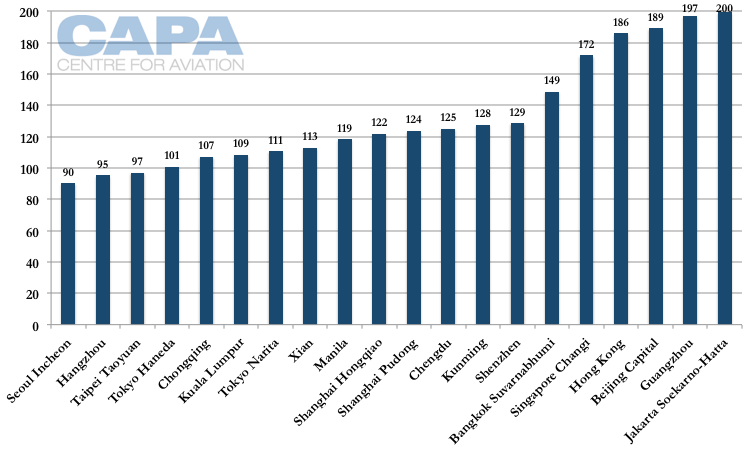
Source: CAPA - Centre for Aviation, ACI and companies
Tokyo Haneda had the fourth-lowest efficiency with 101,000 movements per runway. Only Taipei Taoyuan, Hangzhou and Seoul Incheon had lower movements per runway.
Unlike Haneda, Seoul Incheon for one still has plenty of slots available.
North and Southeast Asia's 20 largest airports by passenger volume ranked on movements per runway: 2013
|
Rank - Movements per Runway |
Rank - Pax Volume |
Airport |
2013 Pax Volume (m) |
Runways |
Movements per Runway (000) |
|
1 |
3 |
60.1 |
2 |
200 |
|
|
2 |
6 |
52.5 |
2 |
197 |
|
|
3 |
1 |
83.7 |
3 |
189 |
|
|
4 |
4 |
59.9 |
2 |
186 |
|
|
5 |
5 |
53.7 |
2 |
172 |
|
|
6 |
20 |
5.14 |
2 |
149 |
|
|
7 |
14 |
32.3 |
2 |
129 |
|
|
8 |
16 |
29.7 |
2 |
128 |
|
|
9 |
12 |
33.4 |
2 |
125 |
|
|
10 |
8 |
47.2 |
3 |
124 |
|
|
11 |
10 |
35.6 |
2 |
122 |
|
|
12 |
13 |
32.9 |
2 |
119 |
|
|
13 |
17 |
Xian |
26 |
2 |
113 |
|
14 |
11 |
35.4 |
2 |
111 |
|
|
15 |
7 |
47.5 |
3 |
109 |
|
|
16 |
18 |
25.3 |
2 |
107 |
|
|
17 |
2 |
68.7 |
4 |
101 |
|
|
18 |
15 |
30.7 |
2 |
97 |
|
|
19 |
19 |
22.1 |
2 |
95 |
|
|
20 |
9 |
41.5 |
3 |
90 |
Haneda's movements per runway of 101,000 are half the 200,000 of Jakarta. In comparison, London Heathrow in 2013 averaged 235,000 movements per runway. Guangzhou, Beijing Capital and Hong Kong saw at least 186,000 movements per runway. Guangzhou and Hong Kong achieved those figures with just two runways.
If Haneda improved the throughput of its runways even to only the average of Asia's top 20 airports (133,000 movements), the airport could secure a greater number of slots than it could by adding a fifth runway.
Making Haneda more efficient is complicated - especially politically
Both Tokyo Haneda and Tokyo Narita have already managed slot increases due to runway and taxiway extensions as well as additional runways.
Infrastructure developments at Tokyo Haneda and Tokyo Narita airports: 2000/2002-2012
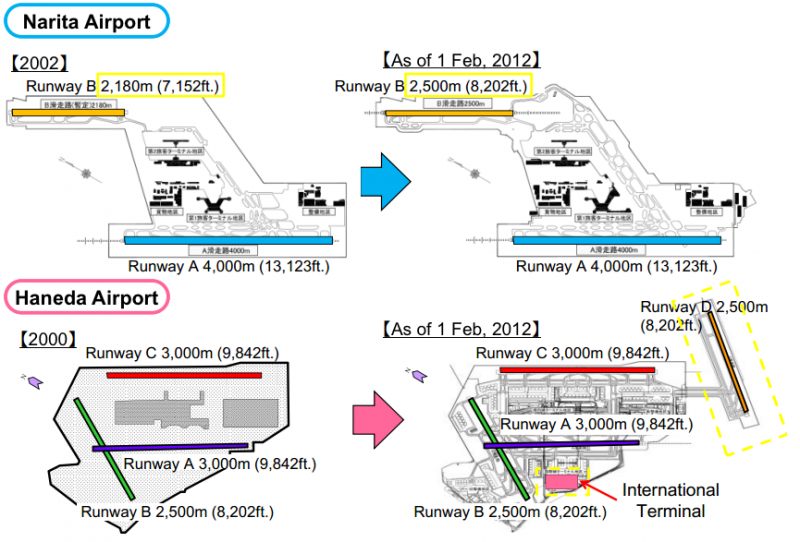
These changes have driven considerable slot increases at Haneda and Narita.
Annual slot changes at Tokyo Haneda and Tokyo Narita airports: 2010-2015

Haneda's being convenient to downtown Tokyo comes with the restriction of flights being unable to overfly a large part of Tokyo in order to limit noise, limiting movement numbers. Greater flying over residential areas would likely require financial compensation to residents.
Haneda air traffic flow
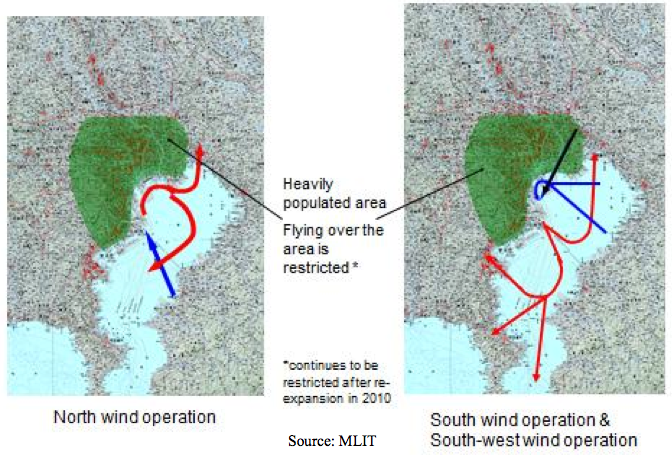
The US Yokota airbase in western Tokyo further restricts airspace, although improvements were made in 2007 to allow Haneda departing flights to climb over Yokota airspace more easily by opening additional flight paths. But further improvement opportunities remain.
Re-design of Tokyo airspace managed by Yokota US airbase: 2007
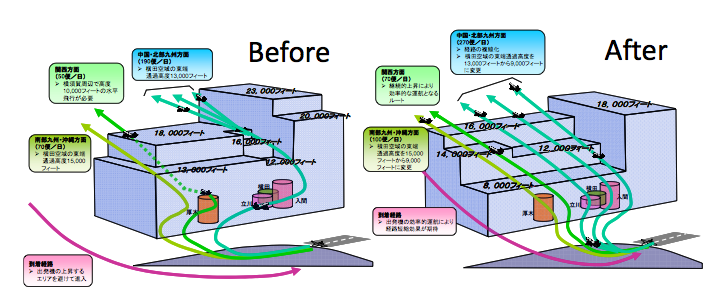
While there have been some improvements to the arrival and departure paths indicated in the 2009 diagrams below, they detail how Haneda only manages a lower throughput per runway than other major airports. London Heathrow in 2009 could handle more traffic with its two runways than Haneda could with three.
Arrival paths at Tokyo Haneda and London Heathrow: 2009
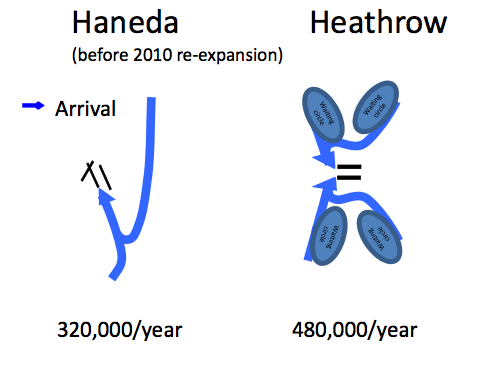
Departure paths at Tokyo Haneda and London Heathrow: 2009
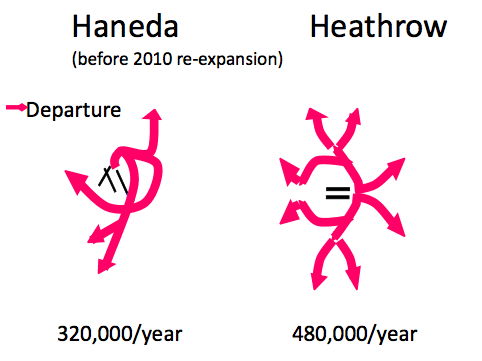
According to the MLIT, Haneda is further restricted owing to the larger number of widebody aircraft using the airport, thereby creating larger wake turbulence and therefore greater separation between aircraft.
Tokyo Haneda is Asia's second-largest airport
Despite these shortcomings, Tokyo Haneda ended 2013 as the world's fourth-largest airport and the second-largest in Asia behind Beijing Capital.
Comparison of Asian airport hubs: 2013
|
Passenger Seat Capacity - Global Rank |
Passenger Seat Capacity - North/Southeast Asia Rank |
Airport |
2013 Pax Volume (m) |
2013 Movements (000) |
|
2 |
1 |
83.7 |
567.8 |
|
|
4 |
2 |
68.7 |
missing |
|
|
10 |
3 |
59.9 |
372.0 |
|
|
12 |
4 |
60.1 |
399.0 |
|
|
13 |
5 |
53.7 |
343.8 |
|
|
17 |
6 |
47.5 |
325.5 |
|
|
19 |
7 |
47.2 |
371.2 |
|
|
20 |
8 |
52.5 |
394.4 |
|
|
22 |
9 |
5.14 |
297.6 |
|
|
24 |
10 |
41.5 |
271.2 |
|
|
34 |
11 |
35.6 |
missing |
|
|
37 |
12 |
32.9 |
237.1 |
|
|
40 |
13 |
35.4 |
221.7 |
|
|
44 |
14 |
30.7 |
194.2 |
|
|
46 |
15 |
32.3 |
257.5 |
|
|
48 |
16 |
33.4 |
missing |
|
|
52 |
17 |
29.7 |
missing |
|
|
57 |
18 |
Xian |
26.0 |
missing |
|
68 |
19 |
25.3 |
missing |
|
|
69 |
20 |
22.1 |
missing |
Haneda reported 2.9% growth in 2013. This was led by a 3.2% increase in domestic passenger numbers but almost flat 0.5% growth in international figures. 2014 should record higher international growth due to the expansion of daytime international slots introduced at the end of Mar-2014 (much of this growth comes at the expense of Tokyo Narita). 89% of Haneda's 2013 passenger traffic was domestic.
The allocation of international slots was closely contested between the main airlines, as was an earlier allocation of domestic slots, emphasising the constraints at Haneda.
See related reports:
- Tokyo Haneda slot allocations fail to generate new flights as Europeans replace Narita operations
- All Nippon Airways grows with new Haneda slots, with some replacement of Narita services
The additional slots introduced in recent times were the result of expanded capacity, primarily made possible from a new international terminal and the opening of the fourth runway. Haneda is now operating at maximum capacity pending structural reforms from airspace to runways to taxiways.
New Tokyo runways come as Asian hubs plan expansion
Additional Tokyo capacity would enable Japan to compete with other countries' expanding hubs. Beijing and Seoul are Tokyo's closest competitors, especially as they compete with Tokyo in the key North America-Asia transfer market. Beijing is planning a new airport for 2018 while Seoul Incheon still operates below its design capacity and has slots available. Below is a summary of planned developments at North and Southeast Asia's 20 largest airports.
Seoul Incheon has benefitted from Tokyo's split airport system by having international passengers fly from non-Tokyo Japanese cities via Incheon, where they transfer in the same airport. A transfer from a domestic Japanese flight to an international one had often required switching from Haneda to Narita airport. This is now decreasing as international flights grow at Haneda.
Comparison of Asian airport hubs and developments: 2013
|
Airport |
2013 Pax Volume (m) |
2013 Movements (000) |
Runways |
Movements per Runway (ooo) |
Planned Developments |
|
83.7 |
567.8 |
3 |
189 |
New Beijing Daxing airport to open in 2018 and eventually have at least six runways for passenger use. Initial capacity will be 40m pax p/a, increasing to 60m by 2025 and later 200m. |
|
|
68.7 |
403.2 |
4 |
101 |
Mooted fifth runway for after 2020, interim airspace adjustments. |
|
|
60.1 |
399.0 |
2 |
200 |
Jakarta operates at nearly three times its designed capacity. A third runway is planned for operation by 2017. A new airport is also planned. |
|
|
59.9 |
372.0 |
2 |
186 |
Third runway proposed and awaiting approval. Construction would not be finished until after 2022. |
|
|
53.7 |
343.8 |
2 |
172 |
Third runway for commercial flights to be completed around 2020 |
|
|
52.5 |
394.4 |
2 |
197 |
Third runway expected to be completed in 2014. |
|
|
47.5 |
325.5 |
3 |
109 |
KLIA has runway capacity still available. |
|
|
47.2 |
371.2 |
3 |
124 |
Third runway opened in 2008 and fourth expected to open in 2014. Pudong has received approval for a fifth runway. |
|
|
41.5 |
271.2 |
3 |
90 |
Fourth runway unlikely until after 2020. Passenger terminal construction prior to that will enable capacity to reach 100m pax p/a. Incheon's three runways can handle 410k movements p/a. |
|
|
35.6 |
243.9 |
2 |
122 |
Second runway opened in 2010. |
|
|
35.4 |
221.7 |
2 |
111 |
Third runway mooted. |
|
|
33.4 |
250.4 |
2 |
125 |
A new airport is due to open in 2018 with five runways and capacity to handle 80m pax p/a. |
|
|
32.9 |
237.1 |
2 |
119 |
San Miguel Corp. proposes to construct a new four-runway airport. |
|
|
32.3 |
257.5 |
2 |
129 |
Second runway completed in 2011. Airport has spoken of a third runway being constructed by 2040. |
|
|
30.7 |
194.2 |
2 |
97 |
Airport hopes for third runway to be completed by 2020, 10 years ahead of the previous plan. Airport expects traffic to rise to 40m pax p/a by 2018. |
|
|
29.7 |
255.5 |
2 |
128 |
New airport opened in Jun-2012. Current capability is 38m pax p/a, which can increase to 60m pax p/a. |
|
|
Xian |
26.0 |
226.0 |
2 |
113 |
Second runway opened in 2012, allowing capacity to reach over 33m pax p/a. |
|
25.3 |
214.6 |
2 |
107 |
Third runway by 2015 that will boost handling to 45m pax p/a. A fourth runway by 2030 will boost handling to 64m pax p/a. |
|
|
22.1 |
190.6 |
2 |
95 |
Existing two runways due to be expanded with a further two runways under evaluation. |
|
|
5.14 |
297.6 |
2 |
149 |
Third runway approved but as reserve facility, with length capped at 3,000m (shorter than existing two runways) with the possibility to expand to 4,000m. |
See related report: Inside the world's biggest airport construction projects in 2013/14
Balancing the needs of Haneda and Narita airports will be difficult
A third runway for Narita seems something of a political concession. Narita is losing traffic as airlines shift service to Haneda, a government-owned facility whereas Narita maintains government affiliation but is run on a commercial basis. Conversely, Narita is gaining movements from low-cost carriers, both foreign and locally based (Jetstar Japan and Vanilla Air are based at Narita; Spring Airlines Japan plans to be based at Narita and Peach Aviation serves Narita from Osaka Kansai).
Haneda is the obvious preference for many, but the government needs to placate Narita and ensure its viability in the short and medium term. If Japan's long-term tourism goals are to be realised, there should be robust growth for Narita. But for now that growth seems distant as foreign carriers leave for rival Haneda. In such a turbulent marketplace as Asia's aviation industry, seemingly anything is possible; if large scale growth does materialise Narita has the advantage of a lower (political) noise profile than Haneda.
New runways commensurate with goal of 20 million visitors by 2020
Airports other than Tokyo have an important role to boost tourism figures and have much growth to unlock. But Tokyo will remain the key gateway for Japan; Tokyo Haneda and Narita have a combined 60% share of Jun-2014 international seat capacity followed by Osaka Kansai with 19% and Nagoya with 7%.
Despite enormous amounts of unused capacity at Japan's numerous unprofitable airports, additional Tokyo capacity is necessary if Japan is to reach its ambitious tourism goals. Japan in 2013 welcomed more than 10 million visitors for its first time. It took 11 years to double 2002's five million visitor figure. But Japan now hopes to double 2013's 10 million figure to 20 million visitors by 2020.
That will require growing visitor numbers by seven million in six years compared to the previous growth of five million visitors in 11 years. Japan expects a further increase to 30 million visitors by 2030.
Japan visitor arrivals and annual growth: 1990-2013, 2020F and 2030F

ANA and JAL would be largest beneficiaries of new capacity. Could revise growth targets
The largest beneficiaries of additional Tokyo capacity would be All Nippon Airways and Japan Airlines. With a fifth runway to be tentatively devoted to international services (to achieve tourism objectives), ANA and JAL will take on larger international roles. ANA wants to have a single hub at Tokyo Haneda rather than a fragmented operation between Haneda and Narita.
But assuming the fifth Haneda runway has the same throughput as its existing four, a quarter of the slots would need to be allocated to support moving ANA's existing international Narita operation to Haneda. If JAL followed suit, slots for entirely new services rapidly dissipate.
Consequently, Tokyo risks a fifth Haneda runway merely becoming an expensive re-distribution, rather than enlargement, of the pie. But if airspace reforms are implemented as mooted, there would be considerable additional Haneda capacity.
JAL chairman Masaru Onishi told Bloomberg in Jun-2014 that Haneda was experiencing a capacity glut and that financial results would suffer. This was perhaps stating the obvious while also skirting some facts. Tokyo airfares remain exceptionally high, as capacity has been capped, as evidenced by JAL's 13% operating margin. With such high fares as starting points, growth was bound to result in lower yields.
See related report: JAL 2013 profit dented by yen depreciation and retrofit costs, but still an enviable 13% margin
Japan has swiftly implemented open skies agreements, including six open skies agreements in nine months over 2010 and 2011. But Gulf carriers and Turkish Airlines remain restricted despite their ability, as made clear in other markets, to grow traffic.
Japan's liberalisation is a drastic change. But still much left to pursue
For all the liberalisation that Japan has undertaken, more awaits. Japan is liberalising its visa environment; recent relaxations for Thailand visas immediately stimulated excellent growth from Thai nationals, along with a flurry of new airline capacity. But the elephant in the room - loosening of restrictions of Chinese visitors - remains. On the aviation front, Japan remains heavily regulated. Japanese airlines cannot board while re-fuelling, have to file fares and negotiate separately for runway and terminal changes, to name but a few. The safety regulator favours ANA and JAL. Restrictive policies on training and hiring pilots is impacting Japan's new LCCs, which have been forced to cancel flights due to inadequate supply in a heavily restricted environment.
See related report: Japan's expanding LCCs drive growth but need cultivating; Spring Airlines and AirAsia re-entry loom
These antiquated approaches are not commensurate with the high visitor growth Japan wants - and needs - to achieve. Modernising such simple matters can deliver immediate benefits - and without digging up Tokyo Bay to add an expensive runway.
Outlook: Runway construction needs to be matched with policy revision
Japan's biggest challenge will be the handling the management of change. There has to be a middle ground between the UK's embarrassing approach towards aviation and China's growth-at-all-costs view. Even assuming the best intentions, Japan has been here before: its poor management of Tokyo Narita led to building a costly offshore airport for Osaka Kansai, rather than try to secure land. Today Kansai's debt remains enormous. Then there are the 90 or so under-utilised and loss-making regional airports, many of them relics of political pork barrelling.
Public sensitivity over airports is diminishing, but at the same time radical movements have sprouted in Japan on both sides of the political spectrum. Without doubt, growth is needed. It seems building new runways is politically more acceptable than doing more with the existing supply by increasing flight density over residential areas (although they are not entirely alone in that regard). This contradicts Japan's much-celebrated "kaizen" concept of constant improvement.
Talk of new runways is in a 2030 timeframe, something that is well beyond political horizons in terms of actual delivery. The risk is that the mammoth political and engineering undertaking needed for them to be realised (not to mention the cost, in a currently frugal government spending environment) will dilute the desire for policy revision. Some of these policies, like not allowing boarding while re-fuelling, are downright antiquated. Open skies with Gulf nations is more complex (but not necessarily justified) due to lobbying from vested interests but progressive liberalisation there would help coordinate tourism goals with airline capacity.
Revising such policies can create opportunities for the present, not 2030. The hope is that by the time the new runways open, few will remember today's anachronisms.
A 15 year strategy must also take into account the inevitable impact that a more open and peripatetic China will have, potentially dwarfing tourism growth from other countries. As today's various territorial disputes illustrate, this will not all be plain sailing, but China seems almost certain to take first place in inbound tourism numbers for most countries in the region as early as 2020. That prospect will not spell unmitigated optimism for Japan in achieving its aggressive tourism goals, but it will offer a means of achieving them.